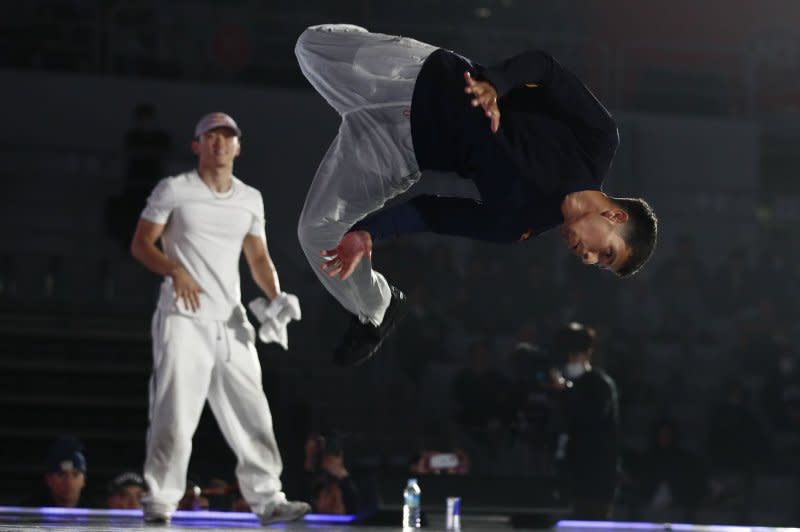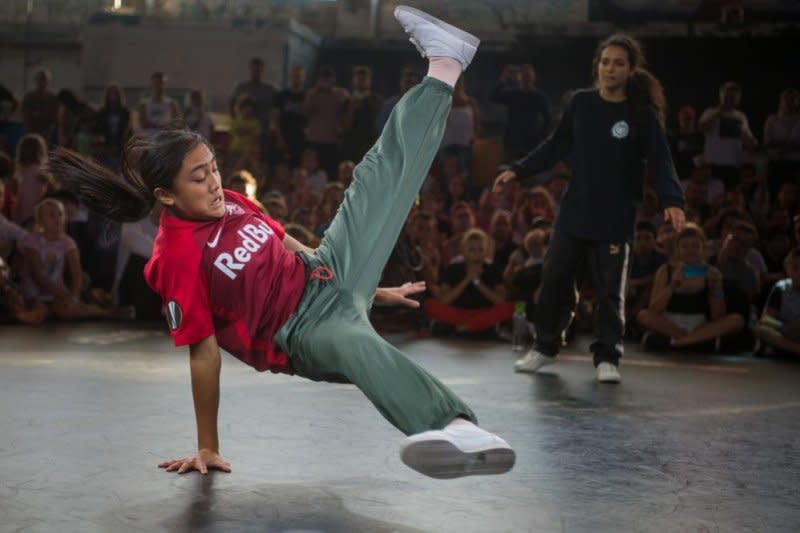Break-dancers seek to elevate sport at Paris Olympics

June 28 (UPI) -- Team USA's first Olympic breaking team is gratified to be a part of the sport's Olympic debut at Paris 2024, but pioneers and officials from the American-birthed dance form remain vexed about its snub from LA 2028.
Sunny "B-Girl Sunny" Choi and Victor "B-Boy Victor" Montalvo were the first Americans to qualify for the historic U.S. breaking team. Jeffrey "B-Boy Jeffro" Louis and Logan "B-Girl Logistx" Edra earned Team USA's remaining spots last weekend in Budapest.
"It's interesting," Louis recently told the Team USA website. "A lot of breakers feel we've got to keep the hip-hop, keep it underground.
"The problem with doing that," he said, "is that you can't shine a lot on the sport by keeping it in the dark."
The young dancers are eager to bring breaking to new heights, but those who built it, starting from Bronx neighborhood parties in the 1970s, feel discouraged about its future after it was left off the program for 2028.

"For me, it's like a slap in the face to the art form and to a hip-hop culture, when you look at the French picking breaking [for Paris 2024], but the country where breaking originated turned its back on it," breaking legend Richard "Crazy Legs" Colón told UPI.
Colón, 58, is widely recognized as one of the best breakers ever. The Bronx native is an original member of the Rock Steady Crew -- a dance group that toured the world -- and has consistently been profiled by media outlets and even performed in movies, includingFlashdance. He also mentors, teaches and facilitates events to further promote young breakers.
Although Colón said that he would "be gutted" to perform at the Olympics while knowing that the United States rejected breaking's placement in the 2028 Summer Games, he also said legendary breakers shouldn't "trample on the futures" of younger Olympians.
Tony "Mr. Wave" Wesley, another pioneer of the dance form, said breaking's inclusion in Paris is "unimaginable."
"It was unimaginable that it would go this far," Wesley told Good Morning America. "It helped us clear our minds. It helped us gain positive thoughts and work real hard at something that we weren't used to working hard at.
"So, for it to move all the way until the Olympics, all the way into this platform, to be recognized globally, it is a feat."
Dance federations from around the world expressed disappointment when breaking was snubbed from the 2028 Summer Games, and they are focused having it included in 2032 in Brisbane, Australia.
In October, World DanceSport Federation president Shawn Tay cited anticipated success in Paris as part of that effort.
"We worked relentlessly over many months to present a powerful and passionate proposal that detailed all the many advantages breaking as a dance sport discipline brings to the Olympic Movement and Olympic Games," Tay said.
"Ensuring the success of breaking's Olympic debut at Paris 2024 is therefore on the forefront of the WDSF agenda."
Thirty-two dancers will compete -- 16 men and 16 women -- at the Summer Games. Team USA, Japan, France, Belgium, Spain, Italy and several South American countries are expected to be top contenders for Olympic glory.
Who to watch
B-Boy Phil Wizard of Canada, B-Boy Shigekix of Japan and B-Boy Dany of France join B-Boy Victor and B-Boy Jeffro among the top expected men's contenders in Paris.
B-Girl Ami of Japan, B-Girl 671 of China, B-Girl Nicka of Lithuania and B-Girl Anti of Italy are among the top women's breakers headed to Paris.
Excitement and spontaneity are intrinsic in breaking, as dancers aren't told the music to which they will perform. They frequently use top rock -- stand-up moves -- and freeze -- when they pause in positions like on their heads and hands -- amid acrobatic routines.
Olympic judges will calculate 60% of the dancers' scores based on performativity and creativity. The other 40% will be based on technique, personality, variety and musicality.
Showstoppers often flow from down rock -- floor moves -- which include spins, footwork, power moves, and transitions. Breakers will spin their bodies while on their hands, elbows, back, shoulders and heads.
Breaking power moves include the Colón-created windmill, head spins and the air flare, which involves circular body rotations while upside down and shifting balance on either arm.
Breakers train for competition in a variety of ways, based on performance strengths, using yoga, weight lifting, and more to maximize power, explosion and flexibility, and to avoid injuries.
Dr. Anatolia Vick-Kregel, the assistant director of fitness and wellness at Rice University, said a good core foundation and strength training routine, conditioning and mobility are vital to avoid injuries.
"That should be across the board, but especially for all breakers, it is vital to have a strong core, which is more than just your abs," Vick-Kregel said.
Breakers should be "doing exercises that that train each aspect of the core, and then given how much they're also on their on their wrists, and doing so much with their upper body, doing a lot of shoulder stability things," she said.
"Really, you want to train those stabilizer muscles, as well, to make sure they are extremely strong and can hold you through these explosive movements."
Vick-Kregel said wrist injuries are the most common ones for breakers, but any moves that put a lot of weight on the head likely involve the most potential for danger.
Breaking battles generally include two or three throw downs -- one-on-one matchups -- leading to the final. The final often features three or five throw downs.
While style and rhythm are uber prevalent during breaking performances, the risk and raw athleticism it takes to compete should keep eyes glued to Olympic coverage.
"You feel our energy," Choi told TIME. "You feel the excitement, you feel the happiness or the anger or whatever emotion that the dancer is expressing in that moment. It's so visceral and raw. I don't think you get that anywhere else."

 Yahoo Sports
Yahoo Sports 
